Related Research Articles

Berkeley is a city on the eastern shore of San Francisco Bay in northern Alameda County, California, United States. It is named after the 18th-century Anglo-Irish bishop and philosopher George Berkeley. It borders the cities of Oakland and Emeryville to the south and the city of Albany and the unincorporated community of Kensington to the north. Its eastern border with Contra Costa County generally follows the ridge of the Berkeley Hills. The 2020 census recorded a population of 124,321.

Emeryville is a city located in northwest Alameda County, California, in the United States. It lies in a corridor between the cities of Berkeley and Oakland, with a border on the shore of San Francisco Bay. The resident population was 12,905 as of 2020. Its proximity to San Francisco, the Bay Bridge, the University of California, Berkeley, and Silicon Valley has been a catalyst for recent economic growth.
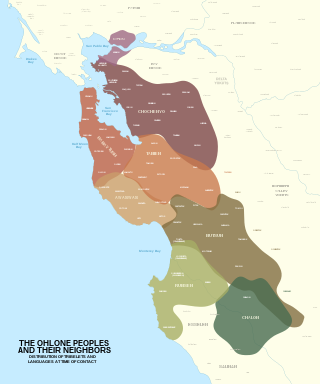
The Ohlone, formerly known as Costanoans, are a Native American people of the Northern California coast. When Spanish explorers and missionaries arrived in the late 18th century, the Ohlone inhabited the area along the coast from San Francisco Bay through Monterey Bay to the lower Salinas Valley. At that time they spoke a variety of related languages. The Ohlone languages make up a sub-family of the Utian language family. Older proposals place Utian within the Penutian language phylum, while newer proposals group it as Yok-Utian.

People's Park in Berkeley, California is a parcel of land owned by the University of California, Berkeley. Located east of Telegraph Avenue and bound by Haste and Bowditch Streets and Dwight Way, People's Park was a symbol during the radical political activism of the late 1960s. Formerly a park, the site is now under construction for new university student housing and homeless supportive housing.
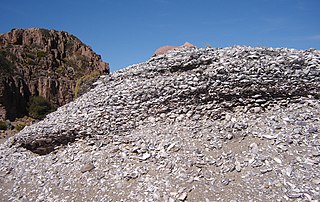
A midden is an old dump for domestic waste. It may consist of animal bones, human excrement, botanical material, mollusc shells, potsherds, lithics, and other artifacts and ecofacts associated with past human occupation.

Ashby station is an underground Bay Area Rapid Transit (BART) station in Berkeley, California. The station is located beneath Adeline Street to the south of its intersection with Ashby Avenue. The station includes park-and-ride facilities with 715 automobile parking spaces in two separate parking lots. It is served by the Orange and Red lines.
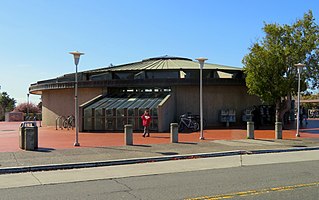
North Berkeley station is an underground Bay Area Rapid Transit (BART) station located in the North Berkeley neighborhood of Berkeley, California. It is bounded by Virginia Street, Sacramento Street, Delaware Street, and Acton Street in a residential area north of University Avenue. The main station entrance sits within a circular building at the center of a parking lot, while an elevator between the surface and the platform is located at the parking lot's Sacramento Street edge. The station is served by the Orange and Red lines.

The Emeryville Shellmound, in Emeryville, California, is a sacred burial site of the Ohlone people, a once-massive archaeological shell midden deposit. It was one of a complex of five or six mounds along the mouth of the perennial Temescal Creek, on the east shore of San Francisco Bay between Oakland and Berkeley. It was the largest of the over 425 shellmounds that surrounded San Francisco Bay. The site of the Shellmound is now a California Historical Landmark (#335).

Emeryville station is an Amtrak station in Emeryville, California, United States. The station is served by the California Zephyr, Capitol Corridor, Coast Starlight, and San Joaquins. The station is the primary connection point for Amtrak Thruway buses serving San Francisco.
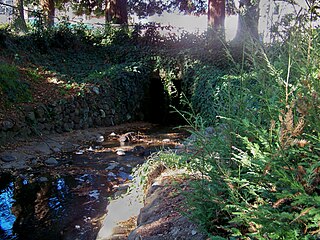
Strawberry Creek is the principal watercourse running through the city of Berkeley, California. Two forks rise in the Berkeley Hills of the California Coast Ranges, and form a confluence at the campus of the University of California, Berkeley. The creek then flows westward across the city to discharge into San Francisco Bay.
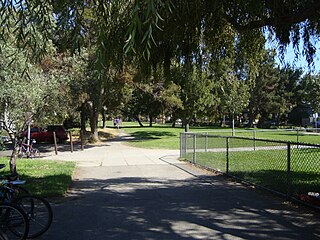
Ohlone Park is a public linear park in the city of Berkeley, California, United States. Directly underground is the subway used by the Bay Area Rapid Transit (BART) Red Line and Orange Line. It is part of the Ohlone Greenway.

Temescal Creek is one of the principal watercourses in the city of Oakland, California, United States.

West Berkeley is generally the area of Berkeley, California, that lies west of San Pablo Avenue, abutting San Francisco Bay. It includes the area that was once the unincorporated town of Ocean View, as well as the filled-in areas along the shoreline west of I-80, mainly including the Berkeley Marina. It lies at an elevation of 23 feet.
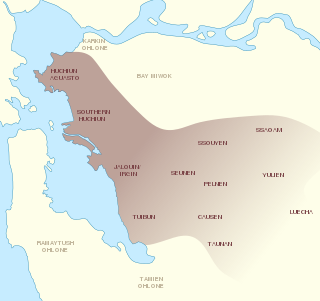
The Chochenyo are one of the divisions of the Indigenous Ohlone (Costanoan) people of Northern California. The Chochenyo reside on the east side of the San Francisco Bay, primarily in what is now Alameda County, and also Contra Costa County, from the Berkeley Hills inland to the western Diablo Range.
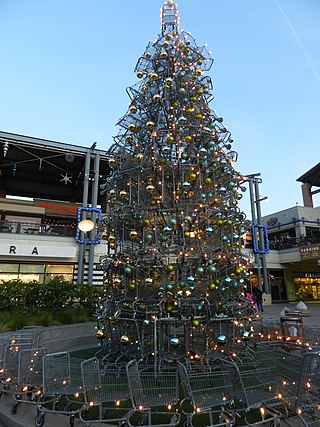
Bay Street Emeryville is a large mixed-use development in Emeryville, California which currently has 65 stores, ten restaurants, a sixteen-screen movie theater, 230 room hotel, and 400 residential units with 1,000 residents.

Indigenous peoples of California, commonly known as Indigenous Californians or Native Californians, are a diverse group of nations and peoples that are indigenous to the geographic area within the current boundaries of California before and after European colonization. There are currently 109 federally recognized tribes in the state and over forty self-identified tribes or tribal bands that have applied for federal recognition. California has the second-largest Native American population in the United States.

Spenger's Fresh Fish Grotto is a historic building and was a seafood restaurant active from 1890 to 2018, at 1919 4th Street in Berkeley, California. The building is listed as a Berkeley Landmark since November 2, 1998. A historic plaque was formally installed at the entrance to the restaurant in 2004 by Berkeley Historical Plaque Project. It was also known as Spenger's Fish Grotto.
The Sogorea Te Land Trust is an urban land trust founded in 2012 with the goals of returning traditionally Chochenyo and Karkin lands in the San Francisco Bay Area to Indigenous stewardship and cultivating more active, reciprocal relationships with the land. The land trust inspired the work of the Tongva Taraxat Paxaavxa Conservancy in the Los Angeles region of Southern California.

Corrina Gould, spokeswoman and Tribal Chair of the Confederated Villages of Lisjan/Ohlone, a non-profit organization. She identifies as a Chochenyo and a Karkin Ohlone woman and is a long-time activist who works to protect, preserve, and reclaim ancestral lands of the Ohlone peoples. The Ohlone people live in the greater San Francisco Bay Area, and Gould's organization, specifically, is located in the East Bay, in regions now occupied by Oakland, Berkeley, and beyond.
Johnella LaRose is an American grassroots organizer based in the San Francisco Bay Area who advocates for Indigenous communities and the preservation and restitution of Indigenous lands. LaRose identifies with the Shoshone Bannock and the unrecognized Carrizo tribe. Alongside fellow Indigenous rights' activist Corrina Gould, LaRose is a co-founder of Indian People Organizing for Change (IPOC), a San Francisco Bay Area-based organization working to protect and raise awareness about the region’s sacred shellmounds, and the Sogorea Te Land Trust, an urban land trust working to restore Indigenous stewardship of occupied Chochenyo and Karkin Ohlone lands in the East Bay Area.
References
- 1 2 "List of Designated City Landmarks, Structures of Merit & Historic Districts" (PDF). City of Berkeley. January 2023. Archived from the original (PDF) on June 30, 2023.
- 1 2 Brandon, Elissaveta M. "Eleven Historic Places in America That Desperately Need Saving". Smithsonian Magazine. Retrieved March 26, 2021.
- ↑ "Berkeley Landmarks: The Shellmound". Berkeley Heritage. Retrieved March 26, 2021.
- ↑ Wollenberg, Charles (2008). Berkeley: A City in History. University of California Press. p. 1. ISBN 978-0-520-25307-0.
- 1 2 3 4 5 6 7 Rosenberg, Eli (March 12, 2024). "Shellmound site will be returned to Ohlone under historic settlement in Berkeley". San Francisco Chronicle.
- 1 2 Raguso, Emilie (March 14, 2016). "Critics question impacts of 'Spenger's parking lot' project on Berkeley Fourth Street, Ohlone heritage". Berkeleyside. Retrieved March 13, 2024.
- ↑ Dinkelspiel, Frances (May 11, 2016). "Second West Berkeley human remains discovery prompts call to re-examine shellmound boundaries". Berkeleyside. Retrieved March 26, 2021.
- ↑ Rudman, Taylor (September 25, 2020). "West Berkeley Shellmound and Village Site named 1 of 11 most endangered historic sites in US". The Daily Californian. Retrieved March 26, 2021.
- ↑ Tang, Amber (October 24, 2019). "Judge rules against developers in West Berkeley Shellmound lawsuit". The Daily Californian. Retrieved March 26, 2021.
- ↑ "Judge rules for Berkeley in developer's lawsuit over Spenger's parking lot". Berkeleyside. October 23, 2019. Retrieved March 26, 2021.
- ↑ Egelko, Bob (April 21, 2021). "Court OKs housing development at site of Ohlone shellmound in Berkeley". San Francisco Chronicle. Retrieved March 13, 2024.
- ↑ "Ruegg & Ellsworth et al. v. City Of Berkeley et al., Confederated Villages Of Lisjan et al" (PDF). Courts.ca.gov. April 20, 2021. Archived from the original (PDF) on August 9, 2021. Retrieved August 9, 2021.
- ↑ "Ruegg & Ellsworth V. City Of Berkeley (Confederated Villages Of Lisjan)". California Courts, Appellate Court Case Information. May 28, 2021.
- ↑ Markovich, Ally (March 12, 2024). "Berkeley will buy Ohlone shellmound site, return it to Indigenous land trust". Berkeleyside. Retrieved March 15, 2024.